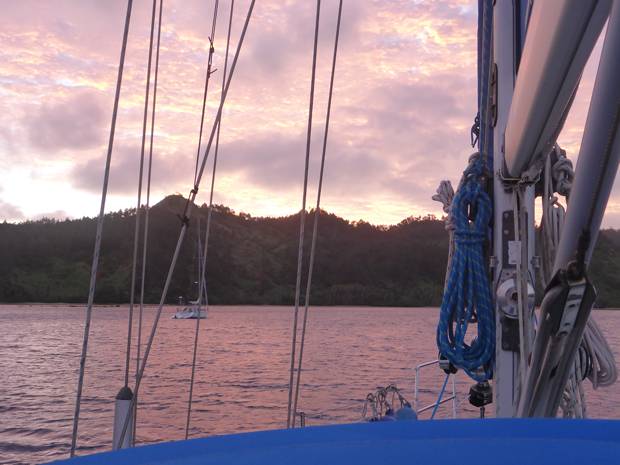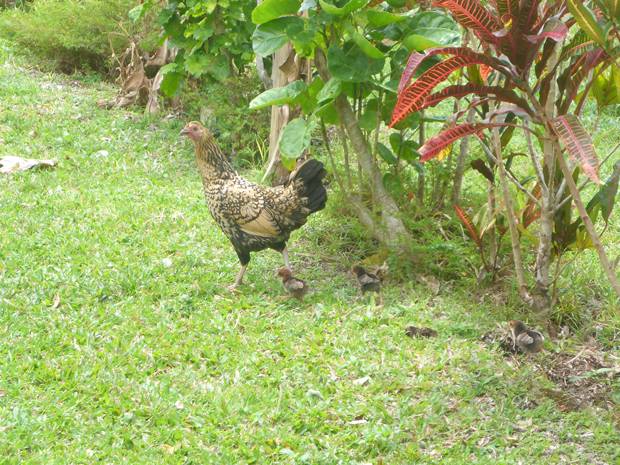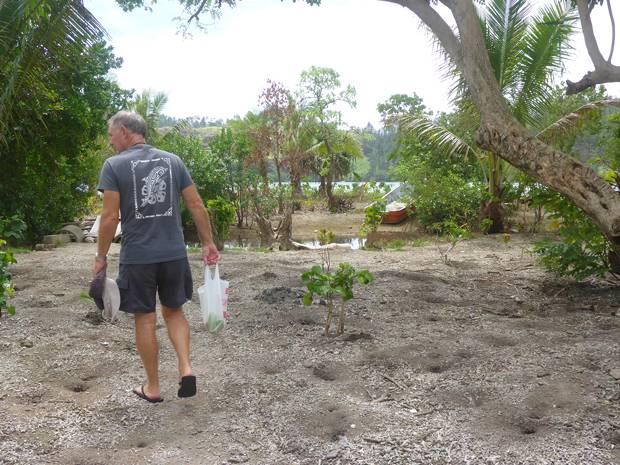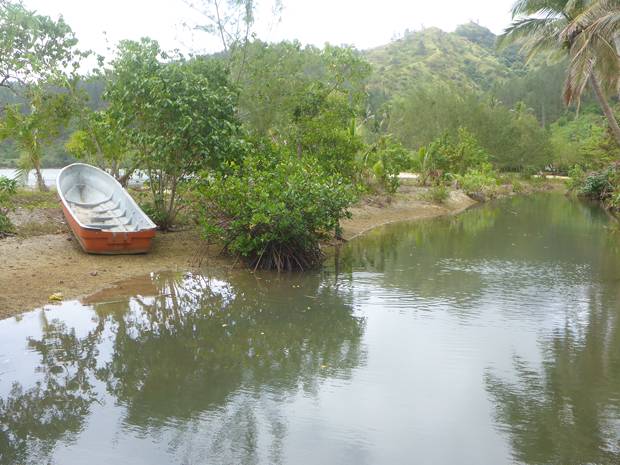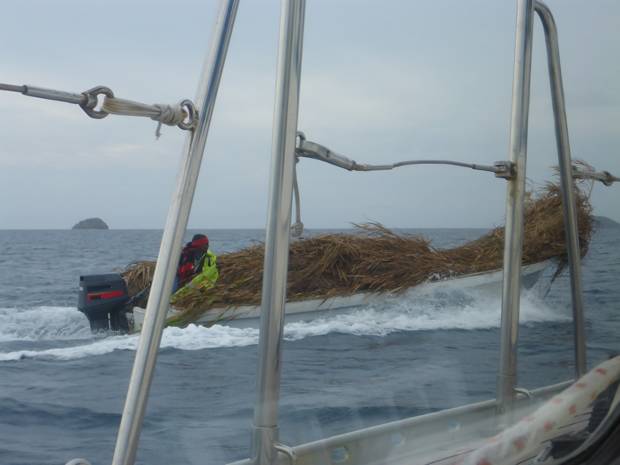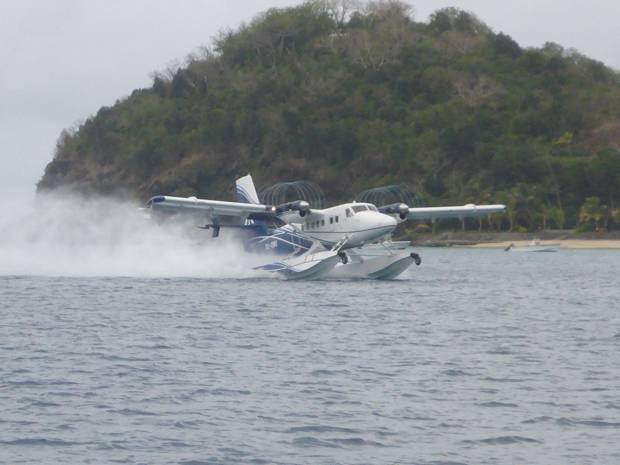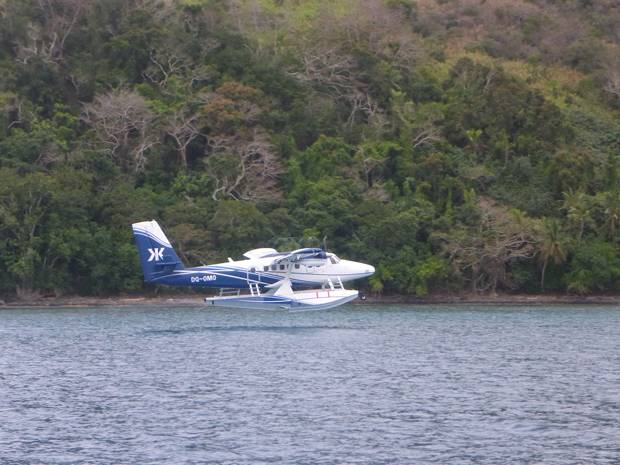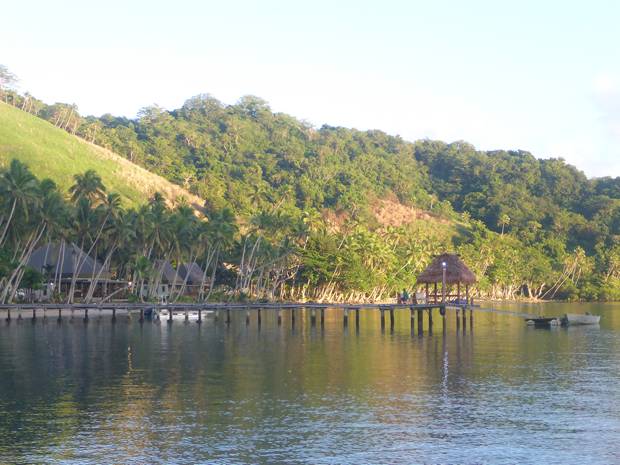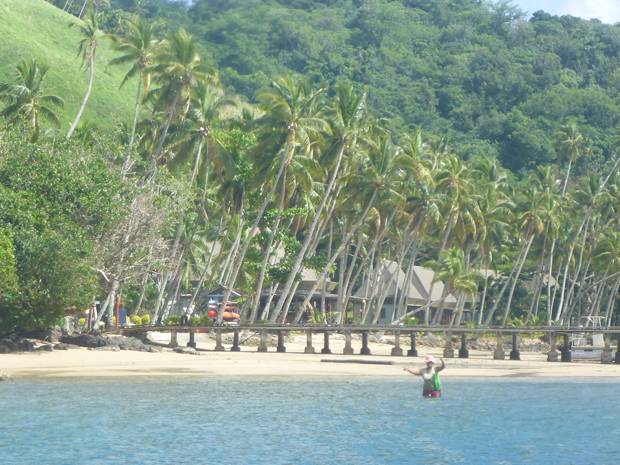Bogi Ono Cagi

|
Bogi Ono Cagi Six night wind on Ono Island Last night (Tuesday 26th September) here in Nubululekaleka Bay, (18:06.53S 178:23.71E) just a few miles from the city of Suva on the main island Viti Levu we and a handful of other cruising yachts on buoys and like us at anchor experienced a humdinger of a thunder storm. We are in this little protected bay on a nice secure mud bottom but when the wind shot into the bay and bent all around it so yachts instead of moving like a group of young synchronised swimmers started veering helter skelter and we came close to one, fortunately occupied, so we could exchange niceties like “Hello, are you dragging?” “No I think we’re ok are you alright?” Then his wife shrieked “Oh God there’s lightning” and dashed below, maybe for the fire extinguisher? So when it eases off a little today we may move a little further away from them. We are here until this blow moves on. It is caused by a high to the east not allowing a massive low to move across, so we are just sitting taking all the rain and wind it has to offer. When we arrived two days ago the water was quite clean but now it looks like a café latte and with Suva City hidden in the rain we could be back in the upper reaches of the Ecuadorian Amazon. But I digress so back to the story. As I mentioned in the last blog we secured Zoonie in a little Bay on Ono Island in the Astrolabe Reef ready for the six night blow. What a nice coincidence that the name of the island, Ono, means six in Fijian. A couple of pangas, looking like floating hedges, still braved the elements to deliver their loads of reed to Kokomo. One panga came from the village around the corner and asked if we had an epoxy glass repair kit and we had to tell him we had given our only one to Chico on Matuku Island. As soon as the weather cleared we went back to the village to deliver the items requested by the chief’s wife and included our old solar panel which might be of use to them. Two more ladies joined the group, a young lass possibly the chief’s daughter and an older lady who retired back to the island after a career of teaching in Suva. We had a nice chat about how she prefers her life here and did not like Suva, while sipping lemon tea made with a single lemon rind peeling in a mug of hot water and nibbling baked sliced plantain (like fat bananas). They gave us six nice green plantains as a parting gift and we wandered back through this pretty village, with its numerous mother chickens and their little broods clucking around the colourful bushes, then across crab city with its hundreds of burrow residences, over the rickety bridge across the little bayou and back to Zoonie. In the afternoon we snorkelled. There were some wonderful really big clams like the ones that used to be common in these waters and little seasnakes lurked at the entrance to their burrows, clearly watching us as we floated above. We won’t be doing sevusevu with them any time soon. The weather was improving and after our prolonged stay here we were ready to move. We anchored off Kokomo again for a snorkel. We had been discussing the idea of taking Zoonie out to the barrier reef where there were two nice anchorage areas over sand shown on the charts, but when the day dawned it was grey and dull so we decided on a known and friendly spot and launched ourselves into the clear water near the resort. It was our ninth wedding anniversary and we had a treat in store. Relaxing in the cockpit, post snorkel cup of hot chocolate in hands, we heard the familiar drone of the seaplane engines as it approached with the latest group of guests. As you know, dear reader, I love anything like that, so we sat excitedly anticipating its arrival. Well you can see from the photos we were not disappointed, in fact the pilot decided by coincidence or design to land straight towards us and an hour or so later to take off between us and the island, just brilliant. I was so happy I sent the photos to Rebekah yesterday and asked if the pilot had intended to buzz us and she replied that she has sent the photos on to all their pilots to find out. If I hear back I’ll let you know. The next day dawned grey again so our trip to the barrier reef was off and instead we motored the 30 or so miles to Beqa Lagoon in 32’ temperature and 70% humidity anchoring off another pretty resort in Malumu Bay. On route we had hosed water via the kitchen tap from the watermaker port tank into the starboard tank while making water to replace it so we were nice and full on arrival. La La was doing some paperwork behind the bar when we went to see if there was any cold beer on offer. “We are closed now, some more people coming next week but I can do a happy hour and beer for you tomorrow?” She said with a lovely big beam. “That’s really kind of you but please don’t open up just for us.” So we stayed in that lovely spot for just one night, with friendly locals waving as they passed or like the lady in the photo, stood waist deep fishing for their supper. The sound of cicadas filled the air evening and morning with the local birds trying very hard to be heard above the cacophony. The next morning after the pink sky faded to blue, we motored around Beqa Island with the hope of finding another resort where we might be able to join a group going out to the barrier reef for a snorkel. But it seems that the surf and dive centres are no longer and all that activity is now run from Pacific Harbour on the mainland. Many dive boats come out and spend a few hours on the reefs never going near the islands. I guess it makes sense if you are flying in on a package holiday to leave for the island from your hotel on the mainland, but once upon a time there were local businesses that must have picked up passing trade and direct bookings by phone. Yanuca Island has a lovely little bay on the north-west side so Zoonie’s hook sped down through the clear blue water and lodged nicely into a patch of white sand amongst the coral and rocks. Ashore we spoke to the man of the resident family who waved a hand towards a substantial building of which at least half the floor area was outdoor with just a roof and low walls and referred to it as his home. Clearly it has morphed into his home and the chalets nearby were no longer in use. “There is a centre just around the headland” he advised, so we took a trip around there in the tender and found a well kept little resort with a group of youngsters playing volleyball. A charming local invited us to sit in the communal building for a chat. The resort is now owned by a local from the village and provides accommodation only. When we asked about snorkelling out at the reef he said the bay we were in was fine snorkelling. Out at the barrier reef the popular sport is reef surfing, again with punters arriving from Pacific Harbour by boat. So we had a good look at the abundance of soft corals that floated like mini trees in the clear waters. They survive storms better than hard rigid corals and will set about restoring a damaged area in a process called ‘phase shift’ which transforms the seabed into predominantly soft corals that help maintain the fish feeding area until the hard corals regrow.
|
